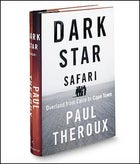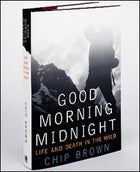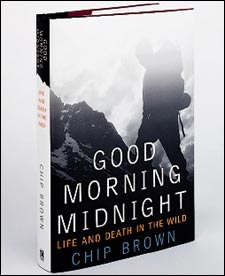DARK STAR SAFARI
BY OUR CONTRIBUTORS
“Being dead is not terribly far off from being on a cruise ship,” Mary Roach writes inStiff: The Curious Lives of Human Cadavers (W.W. Norton, ), her mordantly witty history of the scientific contributions made by the no-longer-living. “Most of your time is spent lying on your back.”


Overland from Cairo to Cape Town
BY PAUL THEROUX
(Houghton Mifflin, $28)
IN 1963, before his prolific writing career began, Paul Theroux spent two years with the Peace Corps teaching in Nyasaland, the former British colony now known as Malawi. Nearly four decades later, fretting over the approach of his 60th birthday and seeking “a sort of revenge on cellular phones and fax machines,” America’s reigning travel writer embarks on a grueling north-south traverse of what he calls “the greenest continent.” Despite an ambitious eight-month itinerary, Theroux writes, “I [was] in my usual traveling mood: hoping for the picturesque, expecting misery, braced for the appalling.” He finds all in ample measure: moonlit nights camping in the Sudanese desert; a long, quiet drift down the Zambezi in a dugout; tense interludes in crime-ridden cities; and a running gag in which aid workers in “spiffy white Land Rovers” repeatedly refuse his requests fora lift. (“They were, in general, oafish self-dramatizing prigs,” he writes, with refreshing spitefulness, “and often complete bastards.”) In Malawi, however, the classic Theroux romp turns tough: He has imagined himself returning someday, “starting a school or whipping a school into shape.” But when he finds the once vibrant library of his former academy a shell with a single bulb dangling from the ceiling, he’s shocked into an epiphany: “I saw the pointlessness, almost the triviality, of my staying and attempting to teach,” he writes. “Only Africans were capable of making a difference in Africa.” —Rob Buchanan GOOD MORNING MIDNIGHT
Life and Death in the Wild
BY CHIP BROWN
(Riverhead, $25)
ONE COLD SUNDAY in February 2000, 67-year-old mountaineer Guy Waterman laced up his boots, hugged his wife, and walked up New Hampshire’s Mount Lafayette to die. Five days later his frozen body was found curled up near the summit. A flurry of articles probed his suicide (including one in ���ϳԹ���, by Rob Buchanan), but journalist Chip Brown stuck with the story to produce this ruminative account of an extraordinary life and death. Born the son of a Yale professor, Waterman was a Capitol Hill speechwriter before alcoholism derailed his career at age 31. But then an article about the Eiger inspired his redemption: “Mountains and mountain climbing dawned on my drunken, shamed, lonely life like a beacon of hope,” he wrote in an unpublished memoir. Waterman and his wife moved off the grid, climbing often and writing classic guides to northeastern crags. His sad fate was set in motion, Brown suspects, by both the prospect of old age and the loss of two of his three sons. Bill, the eldest, disappeared in Alaska in 1973, leaving only a note reading, “Going off on a trip.” Middle son John died under similarly cloudy circumstances on a solo climb of McKinley in 1981. “Plainly,” writes Brown, “something died in Guy Waterman when the breath went out of his sons.” He offers a searing, cerebral portrait of a man who worshiped at the altar of wilderness, even when it claimed his boys and, ultimately, his life. —Bruce Barcott
SMOKECHASING
BY STEPHEN J. PYNE
(University of Arizona Press, $38)
“ABOLISHING FIRE,” writes Stephen J. Pyne, “is not an option.” You can’t stop it; you can only hope to contain it. And as anyone who’s lived through the past few fire seasons in the American West knows, we’ve done a poor job of that. In Smokechasing, a collection of 32 new and previously published essays, the world’s preeminent fire historian explores the Forest Service’s disastrous fire-suppression policy and suggests ways the West might break its current douse-and-explode cycle. An Arizona State history professor, Pyne comes by his expertise honestly, having served 15 seasons on a fire crew on the Grand Canyon’s North Rim. His advice in Smokechasing—make controlled burns and suppression work side by side, not against each other—is hardly shocking. But with the West a veritable tinderbox, we’ll take what we can get. —B.B.
THE WHITE ROCK
An Exploration of the Inca Heartland
BY HUGH THOMPSON
(Overlook Press, $28)
TWENTY-ONE YEARS AGO, a young London bartender named Hugh Thomson and two friends set out for Peru to find the “lost” ruins of Llactapata, a mysterious Incan fortress first glimpsed by American explorer Hiram Bingham in 1911 and then reclaimed by the jungle. The trio located the overgrown complex without much trouble—a hungover local guide got them there in a day—but, as Thomson writes, “it felt like the beginning rather than the end of our journey.” Dodging police roadblocks to push deeper into Peru’s rugged, then-off-limits Vilcabamba massif, where the last of the Incas fled after the Spanish Conquest of 1532, the curious author comes close to the still-flickering core of the culture he seeks to understand, only to be stymied by the nascent Shining Path. When he finally returns, in 1999, he develops an unusual and not implausible argument: that places like Llactapata and Machu Picchu were not religious sites at all but resort towns, as modern and gaudy for their times as Las Vegas. In this, his first book, Thomson, now a documentary filmmaker, proves terrific at weaving snippets of history into his travels, sketching not only the defiant Incas and relentless conquistadores but also the wacky cast of archaeological buccaneers and New Agers that eventually would follow. —R.B.

